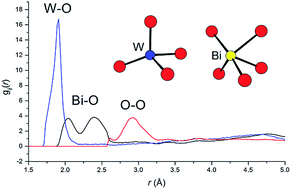当前位置:
X-MOL 学术
›
J. Mater. Chem. A
›
论文详情
Our official English website, www.x-mol.net, welcomes your feedback! (Note: you will need to create a separate account there.)
Local structure and conductivity behaviour in Bi7WO13.5†
Journal of Materials Chemistry A ( IF 11.9 ) Pub Date : 2018-01-09 00:00:00 , DOI: 10.1039/c7ta09225c A. Borowska-Centkowska 1, 2, 3, 4 , M. Leszczynska 1, 2, 3, 4 , F. Krok 1, 2, 3, 4 , M. Malys 1, 2, 3, 4 , W. Wrobel 1, 2, 3, 4 , S. Hull 5, 6, 7, 8 , I. Abrahams 9, 10, 11, 12, 13
Journal of Materials Chemistry A ( IF 11.9 ) Pub Date : 2018-01-09 00:00:00 , DOI: 10.1039/c7ta09225c A. Borowska-Centkowska 1, 2, 3, 4 , M. Leszczynska 1, 2, 3, 4 , F. Krok 1, 2, 3, 4 , M. Malys 1, 2, 3, 4 , W. Wrobel 1, 2, 3, 4 , S. Hull 5, 6, 7, 8 , I. Abrahams 9, 10, 11, 12, 13
Affiliation

|
The structure and electrical properties of the oxide ion conductor Bi7WO13.5 have been examined as a function of temperature using neutron diffraction, differential thermal analysis and a.c. impedance spectroscopy. At room temperature, Bi7WO13.5 exhibits the type Ib tetragonally ordered fluorite structure, with tungsten distributed over two of the six cation sites. Reverse Monte Carlo (RMC) analysis of total neutron scattering data reveals a more realistic picture of the tungsten coordination environment than obtained by the average crystallographic analysis, with tungsten in predominantly tetrahedral coordination and an average bismuth coordination number of around 5. At 893 °C on heating Bi7WO13.5 undergoes a phase transition to a cubic δ-Bi2O3 type phase. The total scattering analysis of this phase reveals significant detail of the local environments of the cations. In particular, a bimodal distribution is found for Bi–O correlations, which has been used to guide the crystallographic analysis. Even in the type Ib phase Bi7WO13.5 shows relatively high conductivity in the intermediate temperature range and measurements of the oxide ion transference number confirm this to be virtually pure ionic in nature. Analysis of the oxide ion vacancy distributions shows a preference for 〈100〉 vacancy pair alignment in both phases. Evidence for a second order phase transition at around 400 °C is discussed.
中文翻译:

Bi 7 WO 13.5 †中的局部结构和电导行为
使用中子衍射,差热分析和交流阻抗谱,已经检查了氧化物离子导体Bi 7 WO 13.5的结构和电性能随温度的变化。在室温下,Bi 7 WO 13.5表现出Ib型四方萤石结构,钨分布在六个阳离子部位中的两个上。所有中子散射数据的反向蒙特卡洛(RMC)分析显示,钨配位环境比通过平均晶体学分析获得的更为真实,钨主要为四面体配位,平均铋配位数为5。在893°C时加热Bi 7 WO13.5经历相转变为立方δ-Bi系2 ö 3型相。该阶段的总散射分析揭示了阳离子局部环境的重要细节。特别是,发现了Bi-O相关性的双峰分布,该分布已用于指导晶体学分析。甚至在Ib型相中,Bi 7 WO 13.5在中间温度范围内也显示出较高的电导率,并且对氧化物离子迁移数的测量证实了它实际上是纯离子性的。氧化物离子空位分布的分析表明,在两个阶段中均优先选择<100>空位对。讨论了在400°C左右发生第二阶相变的证据。
更新日期:2018-01-09
中文翻译:

Bi 7 WO 13.5 †中的局部结构和电导行为
使用中子衍射,差热分析和交流阻抗谱,已经检查了氧化物离子导体Bi 7 WO 13.5的结构和电性能随温度的变化。在室温下,Bi 7 WO 13.5表现出Ib型四方萤石结构,钨分布在六个阳离子部位中的两个上。所有中子散射数据的反向蒙特卡洛(RMC)分析显示,钨配位环境比通过平均晶体学分析获得的更为真实,钨主要为四面体配位,平均铋配位数为5。在893°C时加热Bi 7 WO13.5经历相转变为立方δ-Bi系2 ö 3型相。该阶段的总散射分析揭示了阳离子局部环境的重要细节。特别是,发现了Bi-O相关性的双峰分布,该分布已用于指导晶体学分析。甚至在Ib型相中,Bi 7 WO 13.5在中间温度范围内也显示出较高的电导率,并且对氧化物离子迁移数的测量证实了它实际上是纯离子性的。氧化物离子空位分布的分析表明,在两个阶段中均优先选择<100>空位对。讨论了在400°C左右发生第二阶相变的证据。



























 京公网安备 11010802027423号
京公网安备 11010802027423号